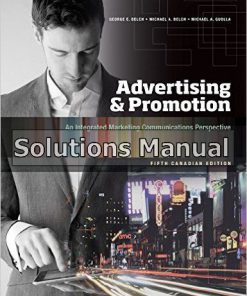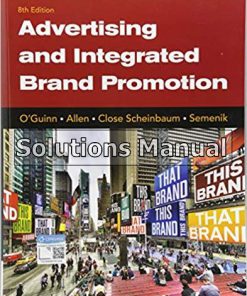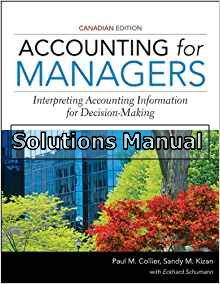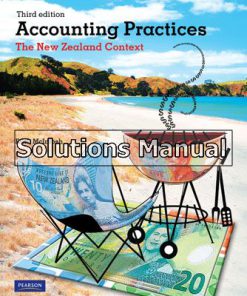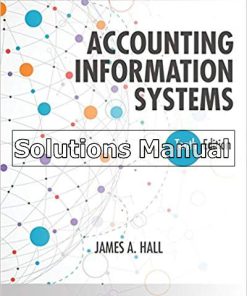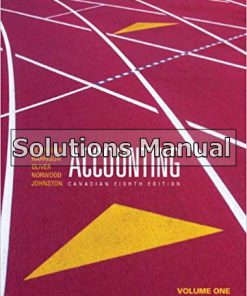Advertising and Promotion Canadian 6th Edition Guolla Solutions Manual
$26.50$50.00 (-47%)
Advertising and Promotion Canadian 6th Edition Guolla Solutions Manual.
You may also like
Advertising and Promotion Canadian 6th Edition Guolla Solutions Manual
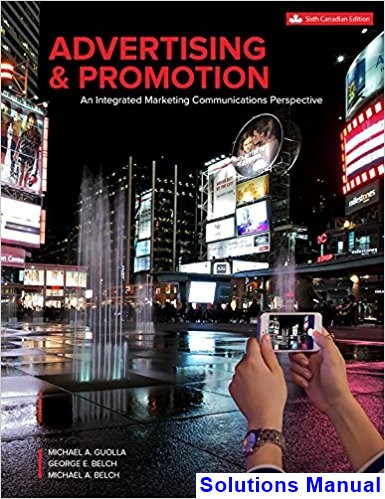
Product details:
- ISBN-10 : 1259272303
- ISBN-13 : 978-1259272301
- Author: Michael Guolla
Guolla/Belch Advertising and Promotion: An IMC Perspective provides students with a basis for understanding the marketing communications process, how it influences consumer decision making, and how to develop promotional strategies. Utilizing a decision oriented framework, the Sixth Canadian Edition offers current Canadian examples and data, an increased focus on social media and mobile technology, current theory, and visual balance through numerous figures and exhibits.
Table contents:
Part One Introduction to Integrated Marketing Communications 2 Chapter One An Introduction to Integrated Marketing Communications The Growth of Advertising and Promotion 5 What Is Marketing? 7 Marketing Focuses on Relationships and Value 8 The Marketing Mix 9 Integrated Marketing Communications 9 The Evolution of IMC 9 A Contemporary Perspective of IMC 11 Reasons for the Growing Importance of IMC 11 The Role of IMC in Branding 15 The Promotional Mix: The Tools for IMC 15 Advertising 17 Direct Marketing 18 Interactive/Internet Marketing 20 Sales Promotion 22 Publicity/Public Relations 22 Personal Selling 23 IMC Involves Audience Contacts 24 The IMC Planning Process 24 Review of the Marketing Plan 26 Promotional Program Situation Analysis 26 Analysis of the Communications Process 31 Budget Determination 31 Developing the Integrated Marketing Communications Program 31 Monitoring, Evaluation, and Control 32 Perspective and Organization of This Text 32 Chapter Two The Role of IMC in the Marketing Process Marketing Strategy and Analysis 41 Opportunity Analysis 41 Competitive Analysis 42 Target Market Selection 43 The Target Marketing Process 44 Identifying Markets 44 Market Segmentation 45 Selecting a Target Market 51 Market Positioning 52 Developing the Marketing Planning Program 58 Product Decisions 59 Price Decisions 60 Distribution Channel Decisions 61 Developing Promotional Strategies: Push or Pull? 62 The Role of Advertising and Promotion 63 Part Two Integrated Marketing Program Situation Analysis 66 Chapter Three Organizing for Advertising and Promotion: The Role of Ad Agencies and Other Marketing Communication Organizations Participants in the Integrated Marketing Communications Process: An Overview 69 Organizing for Advertising and Promotion in the Firm: The Client?s Role 71 The Centralized System 71 The Decentralized System 73 In-House Agencies 75 Advertising Agencies 78 The Ad Agency?s Role 81 Types of Ad Agencies 82 Other Types of Agencies and Services 86 Agency Compensation 88 Commissions from Media 88 Fee, Cost, and Incentive-Based Systems 89 Percentage Charges 90 The Future of Agency Compensation 90 Evaluating Agencies 92 Gaining and Losing Clients 93 Specialized Services 96 Direct-Marketing Agencies 96 Sales Promotion Agencies 96 Public Relations Firms 97 Interactive Agencies 97 Collateral Services 98 Marketing Research Companies 98 Integrated Marketing Communications Services 98 Pros and Cons of Integrated Services 98 Responsibility for IMC: Agency versus Client 99 Chapter Four Perspectives on Consumer Behavior An Overview of Consumer Behavior 105 The Consumer Decision-Making Process 107 Problem Recognition 107 Examining Consumer Motivations 108 Information Search 112 Perception 112 Alternative Evaluation 114 Attitudes 117 Integration Processes and Decision Rules 119 Purchase Decision 119 Postpurchase Evaluation 120 Variations in Consumer Decision Making 121 The Consumer Learning Process 122 Behavioral Learning Theory 122 Cognitive Learning Theory 126 Environmental Influences on Consumer Behavior 126 Culture 126 Subcultures 127 Reference Groups 128 Situational Determinants 129 Alternative Approaches to Consumer Behavior 130 New Methodologies 130 New Insights 130 Part Three Analyzing the Communication Process 134 Chapter Five The Communication Process The Nature of Communication 137 A Basic Model of Communication 139 Source Encoding 139 Message 140 Channel 140 Receiver/Decoding 142 Noise 142 Response/Feedback 142 Analyzing the Receiver 144 Identifying the Target Audience 144 The Response Process 145 Traditional Response Hierarchy Models 146 Alternative Response Hierarchies 148 Implications of the Alternative Response Models 151 The FCB Planning Model 152 Cognitive Processing of Communications 155 The Cognitive Response Approach 155 The Elaboration Likelihood Model 157 Summarizing the Response Process and the Effects of Advertising 159 Chapter Six Source, Message, and Channel Factors Promotional Planning through the Persuasion Matrix 165 Source Factors 166 Source Credibility 166 Source Attractiveness 170 Source Power 178 Message Factors 179 Message Structure 179 Message Appeals 181 Channel Factors 186 Personal versus Nonpersonal Channels 186 Effects of Alternative Mass Media 187 Effects of Context and Environment 187 Clutter 188 Part Four Objectives and Budgeting for Integrated Marketing Communications Programs 190 Chapter Seven Establishing Objectives and Budgeting for the Promotional Program The Value of Objectives 193 Communications 193 Planning and Decision Making 193 Measurement and Evaluation of Results 194 Determining Promotional Objectives 194 Marketing versus Communications Objectives 194 Sales versus Communications Objectives 195 Sales-Oriented Objectives 195 Communications Objectives 199 DAGMAR: An Approach to Setting Objectives 203 Characteristics of Objectives 203 Assessment of DAGMAR 206 Problems in Setting Objectives 207 Improving Promotional Planners? Use of Objectives 207 Setting Objectives for the IMC Program 208 Establishing and Allocating the Promotional Budget 209 Establishing the Budget 209 Budgeting Approaches 215 Allocating the Budget 226 Part Five Developing the Integrated Marketing Communications Program 234 Chapter Eight Creative Strategy: Planning and Development The Importance of Creativity in Advertising 238 Advertising Creativity 240 What Is Creativity? 240 Different Perspectives on Advertising Creativity 240 Planning Creative Strategy 241 The Creative Challenge 241 Taking Creative Risks 243 Creative Personnel 245 The Creative Process 245 Account Planning 246 Inputs to the Creative Process: Preparation, Incubation, Illumination 247 Inputs to the Creative Process: Verification, Revision 249 Creative Strategy Development 252 Advertising Campaigns 252 Copy Platform 252 The Search for the Major Selling Idea 254 Chapter Nine Creative Strategy: Implementation and Evaluation Appeals and Execution Styles 266 Advertising Appeals 267 Advertising Execution 275 Creative Tactics 282 Creative Tactics for Print Advertising 282 Creative Tactics for Television 285 Client Evaluation and Approval of Creative Work 290 Guidelines for Evaluating Creative Output 291 Chapter Ten Media Planning and Strategy An Overview of Media Planning 300 Some Basic Terms and Concepts 301 The Media Plan 303 Problems in Media Planning 303 Developing the Media Plan 306 Market Analysis and Target Market Identification 306 To Whom Shall We Advertise? 307 What Internal and External Factors Are Operating? 309 Where to Promote? 309 Establishing Media Objectives 313 Developing and Implementing Media Strategies 314 The Media Mix 314 Target Market Coverage 314 Geographic Coverage 315 Scheduling 315 Reach versus Frequency 317 Creative Aspects and Mood 322 Flexibility 324 Budget Considerations 324 Evaluation and Follow-Up 327 Characteristics of Media 327 APPENDIX A: Sources of Media Information 333 Chapter Eleven Evaluation of Broadcast Media Television 338 Advantages of Television 338 Limitations of Television 340 Buying Television Time 344 Network versus Spot 344 Methods of Buying Time 349 Selecting Time Periods and Programs 350 Cable Television 351 Measuring the TV Audience 357 Radio 362 Advantages of Radio 363 Limitations of Radio 366 Buying Radio Time 367 Time Classifications 369 Audience Information 369 Chapter Twelve Evaluation of Print Media The Role of Magazines and Newspapers 377 Magazines 377 Classifications of Magazines 377 Advantages of Magazines 380 Disadvantages of Magazines 387 Magazine Circulation and Readership 389 Audience Information and Research for Magazines 391 Purchasing Magazine Advertising Space 392 The Future for Magazines 393 Newspapers 396 Types of Newspapers 396 Types of Newspaper Advertising 398 Advantages of Newspapers 399 Limitations of Newspapers 401 The Newspaper Audience 402 Purchasing Newspaper Space 403 Newspaper Rates 404 The Future for Newspapers 405 Chapter Thirteen Support Media The Scope of the Support Media Industry 415 Traditional Support Media 415 Outdoor Advertising 415 Alternative Out-of-Home Media 417 In-Store Media 419 Miscellaneous Outdoor Media 419 Transit Advertising 420 Measurement in Out-of-Home Media 423 Promotional Products Marketing 424 Advantages and Disadvantages of Promotional Products Marketing 424 Measurement in Promotional Products Marketing 426 Yellow Pages Advertising 427 Other Traditional Support Media 429 Advertising in Movie Theaters 429 In-Flight Advertising 430 Nontraditional Support Media 432 Branded Entertainment 432 Miscellaneous Other Media 439 Chapter Fourteen Direct Marketing Direct Marketing 446 Defining Direct Marketing 447 The Growth of Direct Marketing 447 The Role of Direct Marketing in the IMC Program 449 Direct-Marketing Objectives 450 Developing a Database 450 Direct-Marketing Strategies and Media 456 Direct Selling 461 Evaluating the Effectiveness of Direct Marketing 462 Advantages and Disadvantages of Direct Marketing 463 Chapter Fifteen The Internet and Interactive Media A Brief History of the Internet 469 Why the Rapid Adoption of the Internet? 469 Web Objectives 470 Developing and Maintaining a Website 470 Communications Objectives 473 E-Commerce 475 The Internet and Integrated Marketing Communications 476 Advertising on the Internet 476 Sales Promotion on the Internet 479 Personal Selling on the Internet 481 Public Relations on the Internet 482 Direct Marketing on the Internet 482 Measuring Effectiveness of the Internet 483 Audience Measures and Measures of Effectiveness 484 Sources of Measurement Data 485 Advantages and Disadvantages of the Internet 486 Additional Interactive Media 487 Wireless 488 Chapter Sixteen Sales Promotion The Scope and Role of Sales Promotion 495 The Growth of Sales Promotion 496 Reasons for the Increase in Sales Promotion 497 Concerns about the Increased Role of Sales Promotion 502 Consumer Franchise-Building versus Nonfranchise-Building Promotions 502 Consumer-Oriented Sales Promotion 503 Objectives of Consumer-Oriented Sales Promotion 503 Consumer-Oriented Sales Promotion Techniques 507 Sampling 507 Couponing 510 Premiums 516 Contests and Sweepstakes 518 Refunds and Rebates 521 Bonus Packs 522 Price-Off Deals 522 Loyalty Programs 522 Event Marketing 523 Summary of Consumer-Oriented Promotions and Marketer Objectives 524 Trade-Oriented Sales Promotion 525 Objectives of Trade-Oriented Sales Promotion 525 Types of Trade-Oriented Promotions 527 Coordinating Sales Promotion and Advertising 533 Budget Allocation 534 Coordination of Ad and Promotion Themes 534 Media Support and Timing 534 Sales Promotion Abuse 536 Chapter Seventeen Public Relations, Publicity, and Corporate Advertising Public Relations 543 The Traditional Definition of PR 543 The New Role of PR 543 Integrating PR into the Promotional Mix 544 Marketing Public Relations Functions 544 The Process of Public Relations 546 Determining and Evaluating Public Attitudes 546 Establishing a PR Plan 547 Developing and Executing the PR Program 548 Advantages and Disadvantages of PR 553 Measuring the Effectiveness of PR 554 Publicity 556 The Power of Publicity 557 The Control and Dissemination of Publicity 559 Advantages and Disadvantages of Publicity 561 Measuring the Effectiveness of Publicity 561 Corporate Advertising 561 Objectives of Corporate Advertising 563 Types of Corporate Advertising 563 Advantages and Disadvantages of Corporate Advertising 569 Measuring the Effectiveness of Corporate Advertising 569 Chapter Eighteen Personal Selling The Scope of Personal Selling 574 The Role of Personal Selling in the IMC Program 575 Determining the Role of Personal Selling 575 The Nature of Personal Selling 576 Advantages and Disadvantages of Personal Selling 583 Combining Personal Selling with Other Promotional Tools 585 Combining Personal Selling and Advertising 585 Combining Personal Selling and Public Relations 586 Combining Personal Selling and Direct Marketing 586 Combining Personal Selling and Sales Promotion 588 Combining Personal Selling with the Internet 588 Evaluating the Personal Selling Effort 589 Criteria for Evaluating Personal Selling 591 Part Six Monitoring, Evaluation, and Control 594 Chapter Nineteen Measuring the Effectiveness of the Promotional Program Arguments for and Against Measuring Effectiveness 597 Reasons to Measure Effectiveness 597 Reasons Not to Measure Effectiveness 599 Conducting Research to Measure Advertising Effectiveness 602 What to Test 602 When to Test 603 Where to Test 606 How to Test 606 The Testing Process 607 Concept Generation and Testing 607 Rough Art, Copy, and Commercial Testing 608 Pretesting of Finished Ads 611 Market Testing of Ads 616 Establishing a Program for Measuring Advertising Effects 623 Problems with Current Research Methods 623 Essentials of Effective Testing 624 Measuring the Effectiveness of Other Program Elements 624 Measuring the Effectiveness of Sales Promotions 624 Measuring the Effectiveness of Nontraditional Media 626 Measuring the Effectiveness of Sponsorships 626 Measuring the Effectiveness of Other IMC Program Elements 627 Part Seven Special Topics and Perspectives 632 Chapter Twenty International Advertising and Promotion The Importance of International Markets 635 The Role of International Advertising and Promotion 637 The International Environment 638 The Economic Environment 638 The Demographic Environment 639 The Cultural Environment 641 The Political/Legal Environment 643 Global versus Localized Advertising 646 Advantages of Global Marketing and Advertising 646 Problems with Global Advertising 647 When Is Globalization Appropriate? 648 Global Products, Local Messages 651 Decision Areas in International Advertising 652 Organizing for International Advertising 652 Agency Selection 655 Advertising Research 658 Creative Decisions 659 Media Selection 660 The Roles of Other Promotional Mix Elements in International Marketing 665 Sales Promotion 665 Personal Selling 668 Public Relations 669 The Internet 670 Chapter Twenty-one Regulation of Advertising and Promotion Self-Regulation 678 Self-Regulation by Advertisers and Agencies 678 Self-Regulation by Trade Associations 679 Self-Regulation by Businesses 681 The National Advertising Review Council and the NAD/NARB 682 Self-Regulation by Media 684 Appraising Self-Regulation 688 Federal Regulation of Advertising 688 Advertising and the First Amendment 688 Background on Federal Regulation of Advertising 689 The Federal Trade Commission 691 The Concept of Unfairness 692 Deceptive Advertising 692 The FTC?s Handling of Deceptive Advertising Cases 697 Current Status of Federal Regulation by the FTC 700 Additional Federal Regulatory Agencies 701 The Lanham Act 704 State Regulation 706 Regulation of Other Promotional Areas 706 Sales Promotion 706 Marketing on the Internet 710 Chapter Twenty-two Evaluating the Social, Ethical, and Economic Aspects of Advertising and Promotion Advertising and Promotion Ethics 719 Social and Ethical Criticisms of Advertising 721 Advertising as Untruthful or Deceptive 721 Advertising as Offensive or in Bad Taste 722 Advertising and Children 726 Social and Cultural Consequences 731 Summarizing Social Effects 739 Economic Effects of Advertising 741 Effects on Consumer Choice 742 Effects on Competition 742 Effects on Product Costs and Prices 744 Summarizing Economic Effects 745 Glossary of Advertising and Promotion Terms 749 Endnotes 763 Credits and Acknowledgments 791 Name and Company Index 795 Subject Index 807
People also search:
advertising and promotion an integrated marketing
canadian advertising in action 11th edition
advertising and promotion quizlet
c and c promotions
d and d promotions


